(The trip’s officially ‘over’, I’m back in New Mexico, but there’s still a few posts I’ve yet to upload… This missive comes to you courtesy of VSCO’s Kodak Gold emulation, because I was feeling nostalgic)
La Paz – Achacachi – Moho – Juliaca – Nicaso – Pupuja – Ayaviri – Sicuani – Checacupe – Pitamarca. 230km of railway link Juliaca to Checacupe (at which point we veered north to bikepack across the Ausungate range), before wending onwards to Cusco. The train line runs roughly parallel to the main road, avoiding pavement and associated traffic for 80% of the way. Sometimes this means riding railside singletrack, connecting dirt roads, or even across the actual railway sleepers. Disclaimer: not recommended for bikes without fat tyres!
I have Kurt to thank for this one. And the venerable Pugsley too. Without either of them, it’s unlikely I’d have considered riding over 200kms along/on top/beside an Andean railway line.
As it is, tackling the Cusqueñan railtrail proved to be one of the more unusual highlights of this Americas ride, and a memorable way to reaching the old Incan capital of Cusco, especially when coupled with the Ausungate traverse (more on that little gem later). Certainly, it helped lift my spirits after a sorrowful Bolivian farewell – a country that lived up to my every expectation – and provided a fitting finale to the end of this journey.
After the striking scenery of the high Altiplano, the paved ride around the quiet, eastern shores of Lago Titicaca seemed relatively uneventful. Segmented by a flurry of quality dirt across the actual border, the fun didn’t really begin until after the sprawling settlement Juliaca – a noisy, rambunctious city, even by Peruvian standards, home to the gracious Giovanni and his newfound Casa de Ciclistas.
In fact, given the relative peace and serenity of Bolivia (drunken fiestas notwithstanding), Juliaca’s gridlocked traffic and swarms of tuk-tuks came as something of a jarring surprise. Visa stamps procured in nearby Puna, it wasn’t long before Miguel and I were escaping the city on a scrap of dirt, squeezed between the main highway and the rail line, preferring to bounce along rough tracks and dodge trash than have trucks and buses buzz by. The plan was to make maximum use of our fat tyres, following the historic railway line that runs to Cusco – as Kurt had done the year before – before peeling off towards 6384m Ausungate, reported to be amongst the most beautiful mountain folds in the country.
And, bar the odd push and grunt, it all pieced together spectacularly well. At times a decent dirt road even ran alongside the rail lines, completely bereft of traffic, except for kids pedalling to school. But generally, we picked our way along a footpath, beside the actual rails, or we dipped onto singletrack worn smooth by motorbikes that shortcut across the pampa. We passed little more than old railway villages and llamas, surprising children and elderly folk alike. Before the advent of the highway, this was the main mode of transport for locals; now it’s just a couple of tourist trains that trundle past by each day. Gringos who stop in such settlements are thus a rare commodity – cue a barrage of enquiries at every stop. ‘No te cansa?’ Don’t you get tired? The lady at the store seems particularly preocuppied with the state of my riñones – kidneys. Clearly, she didn’t grasp the plush comfort afforded by fat tyres.
In another railroad village, an old man in a smart trilbe rolled over for a chat, leaning on his Indian singlespeed with a solemn air. Once we’d fielded his tirade of questions, he commented: ‘How sad. It must be so cold at night. And what do you do when it rains?’ It was true, the first of the storms had arrived, signalling a shift in the seasons. By afternoon, sunny skies were laden with clouds. They circled us conspiratorially and lent further drama to the landscape.
But we pedalled on, scything across the valley on our fat tyres, following a trail of endless rails…
A note on fatbikes:
The more I tour, the more I’m smitten by these remarkable bikes, and the unparalleled scope they offer in terms of exploration – ample reward in my mind for their inevitable compromises on pavement and their extra heft. Beach, ripio, snow, singletrack, rock… and now railways. Truly, these machines have inherited the All Terrain Bike crown. More thoughts on travelling on my Surly Pugsley coming soon…
If you would like to keep up with where I am between tardy blog entries, I keep my While Out Riding Facebook page more regularly updated – along with posting extra photos and gear ponderings. You can find it here. Occasionally, I pop some pictures up on my Instagram feed. And if you haven’t overdosed by then, I’ve also started a While Out Riding Tumblr edition, focusing on photography.
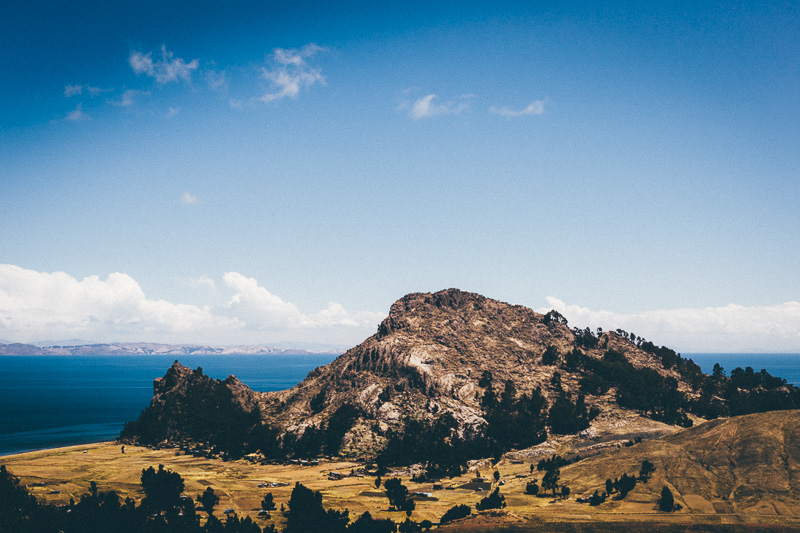
Lago Titicaca, 3800m, the largest lake by volume in South America. And where all life began, so say the Incans.
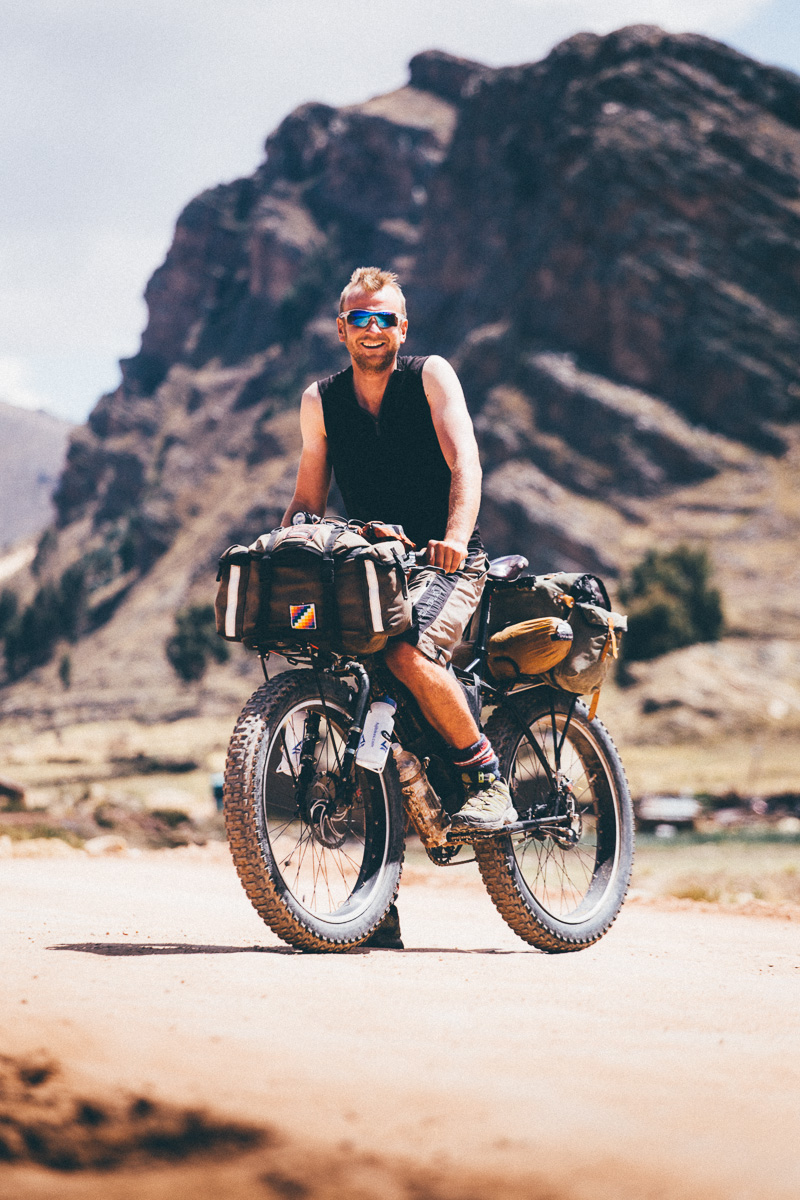
Pugsley pin-up boy! Miguel has joined the fold, having bought Andi’s bike in La Paz. He’ll be carrying the fatbike flame north to Colombia.

At the border, we burn through our last few Bolivianos on endless rounds of thirst quenching mocochinchi… complete with soaked peach chasers.
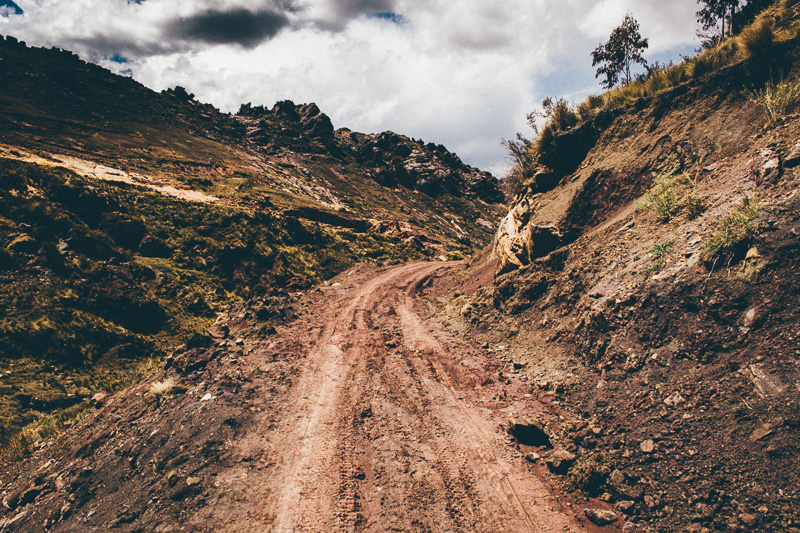
The route we follow keeps to the quieter, eastern side of Lago Titicaca, where there are various roads that enter Peru. Inevitably, we appear to unearth the steepest, roughest option…

Election season is coming up in a couple of weeks, so even the remotest roads are adorned with political graffiti.

Gridlocked Juliaca is chocablock with tuk-tuks, and feels more like India than Peru. Thankfully, Giovanni has opened his home to passing cyclists, creating a peaceful haven to rest up for a day or two.

Oh Lomo Saltado, how I’ve missed you. Peru’s national dish is one of my all time South American favourites: slivers of beef, pepper, onions and garlic, on a bed of chips. Yum!

Leaving Juliaca, we soon escape the hubub of the main highway to Cusco, taking advantage instead of gentle grades and a doubletrack that flanks the railway line.

‘Parace llantas de moto!’ They look like motorbike tyres! Such are the words we hear dozens of times a day. Fat bikes are people magnets!

As does this fellow, piloting the coolest cargo bike payload I’ve seen. He’s off to market, where alpacas fetch 200 Sol ($70) each.

Away from the mountains, Peru is one clamorous country… And with elections coming up, noise pollution is at an all time high. All the parties are making their presence known – both aurally, via megaphones strapped to car rooves…

…. or in painting their emblems – a spade, an orange, a pair of sandals – on any available wall. This, for example, would be the work of the Potato Party.

Compared to Bolivia, food in Peru veritably abounds. Common advice is never eat ceviche away from the coast… but this market platter tastes great, and soon has us in spicy tears.
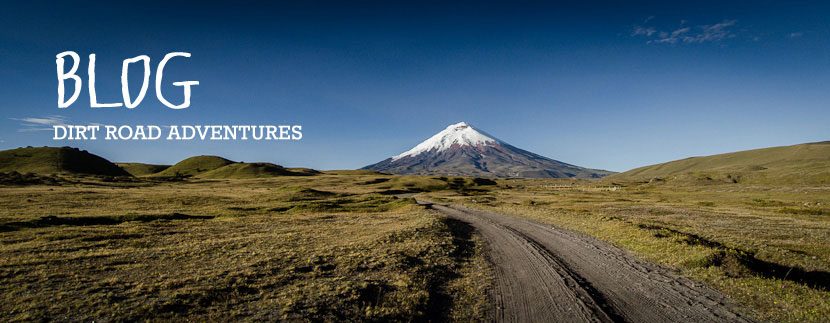


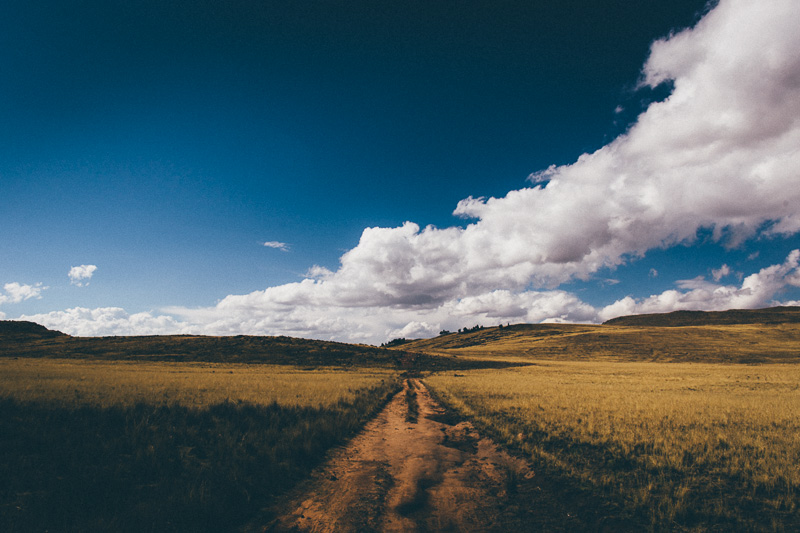




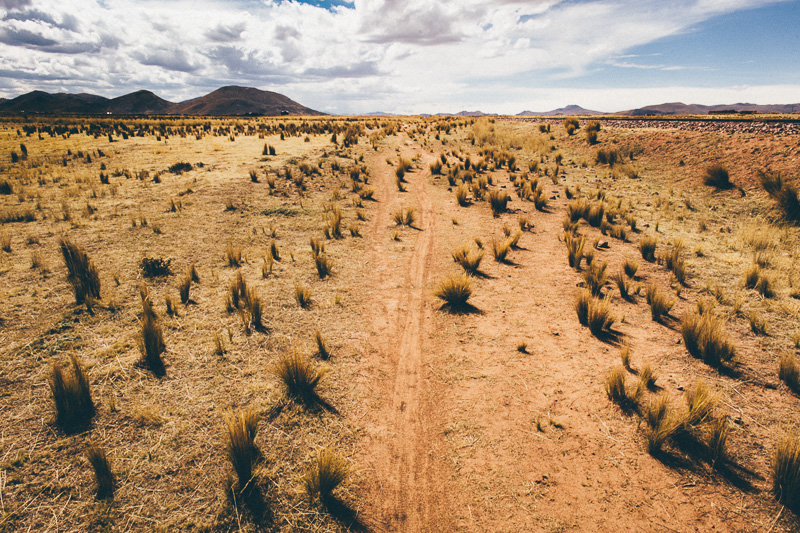
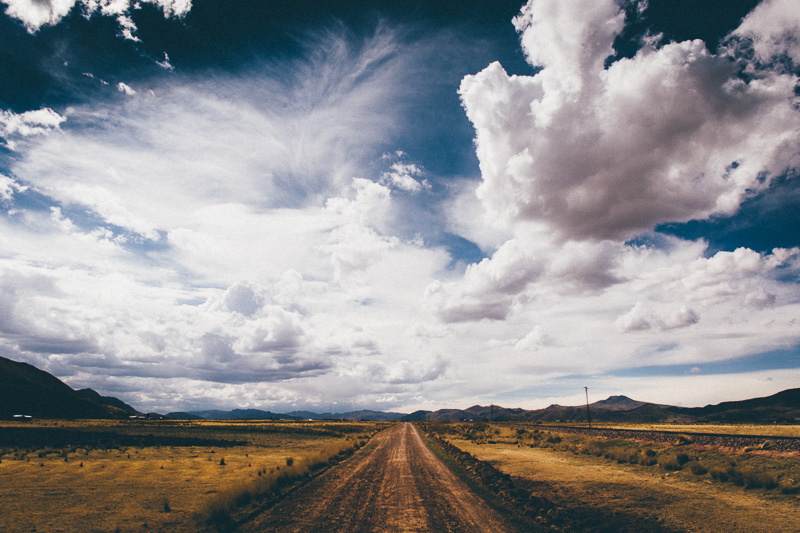
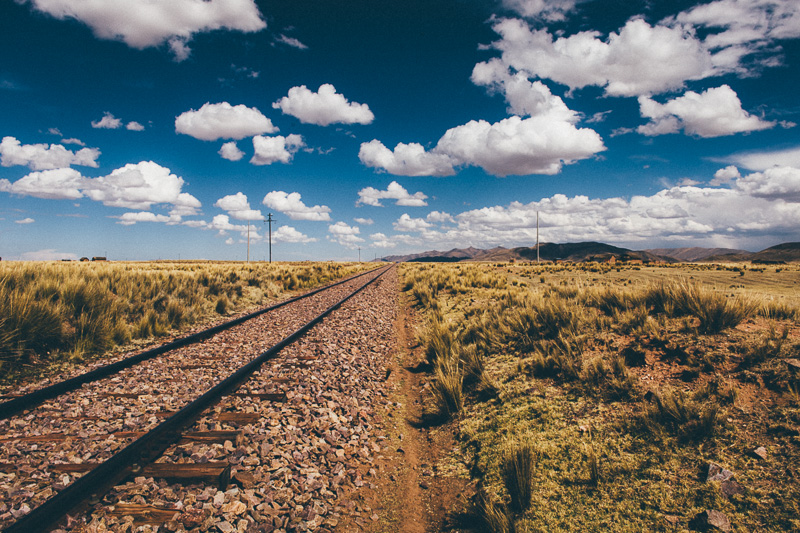
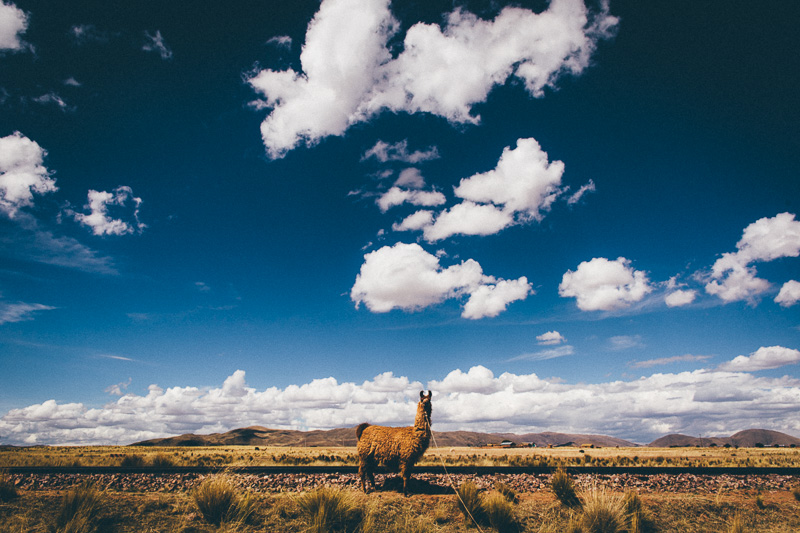
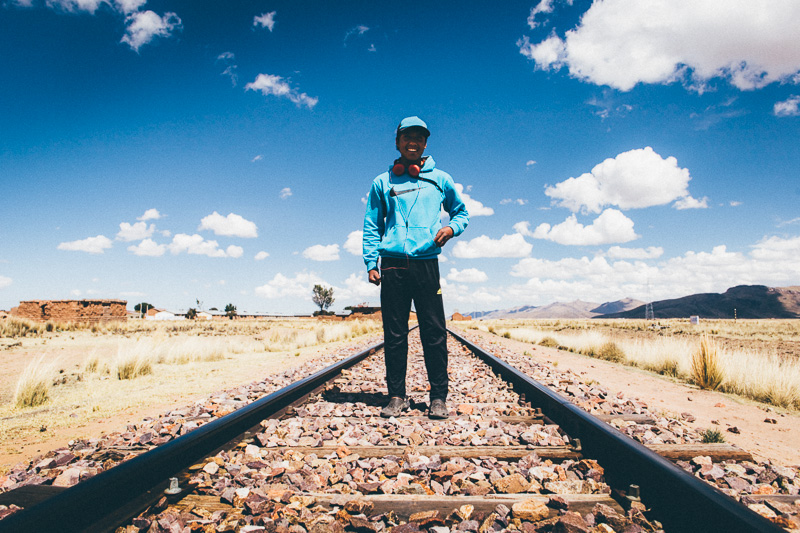

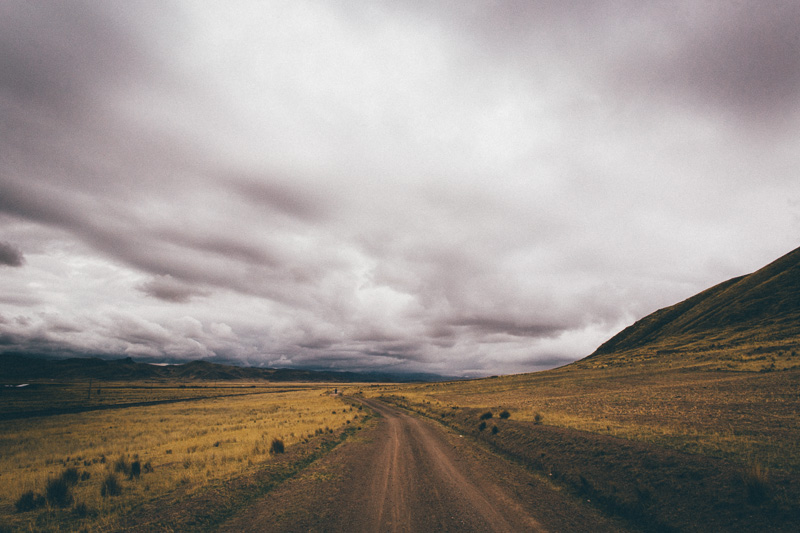
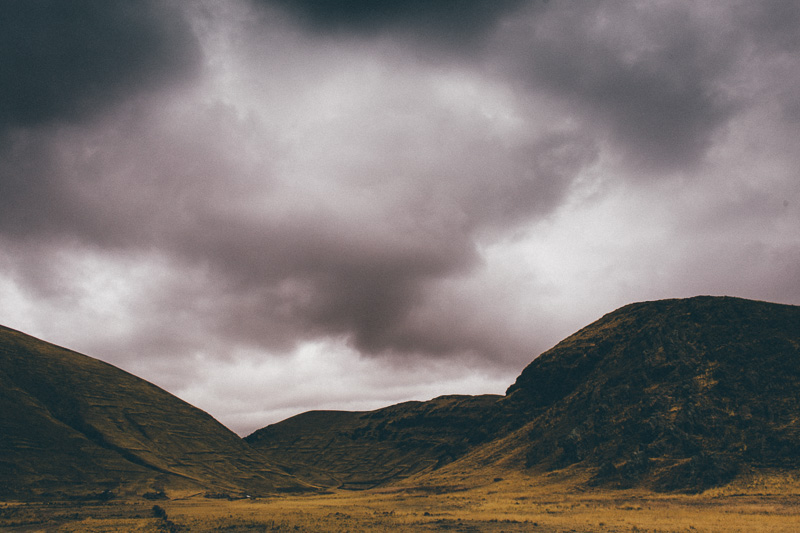
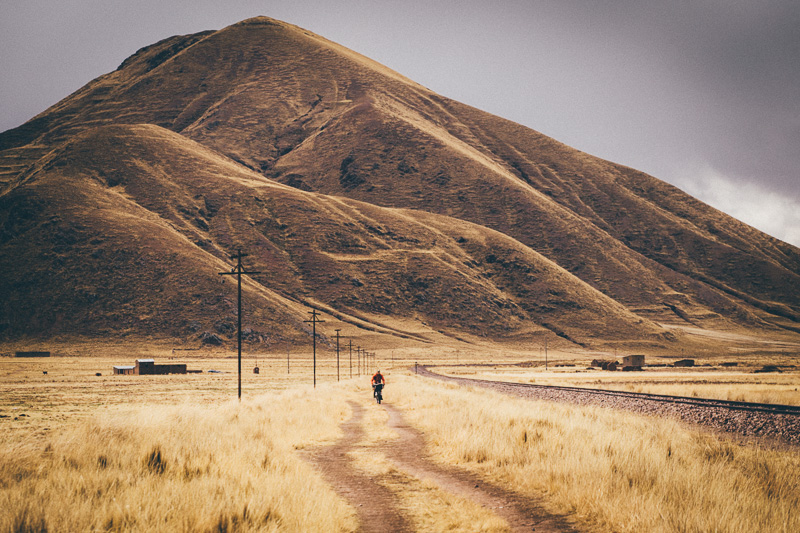













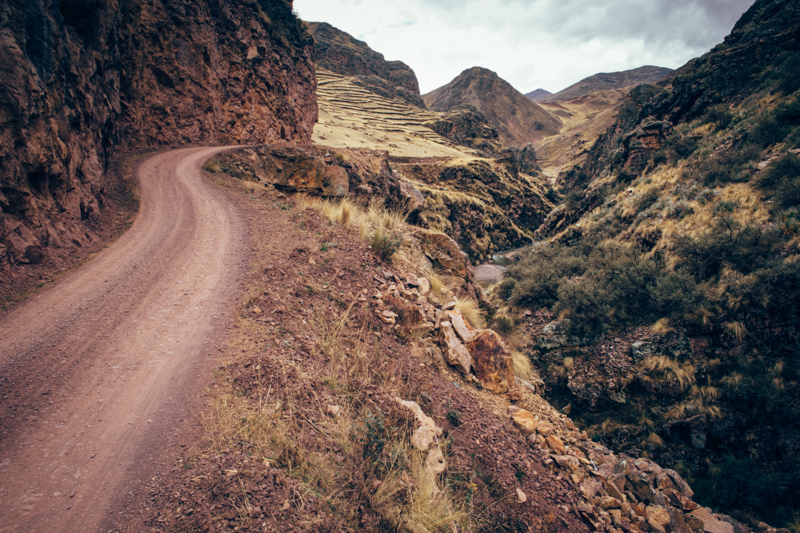

Despite you using the word ‘fat’ eight times in this post it’s a great read. Glad i wasnt with u on the sidings but great to see the pics. Great stuff.
Damn, I was hoping to hit double figures. Seriously though, once aboard such a steed, the correct terminology for propelling oneself forward is fatbiking. Not just biking…
What a ride!
Pleasure to have shared it with you!
Loving the pics, makes me feel just as nostalgic……maybe minus the bushwhacks.
Keeping it real.
Pugsley Pin Up Boy
Indeed, the feeling is mutual Señor!
And I miss the roar of your ‘Floaters’ (for want of a better word) drowning out all traffic, and scarring the bejeezus out of passers by (-;
That pin-up shot is just perfect! I have to admit I miss Nikita a little .. Though Mara is going to be up and rolling within the next two weeks. 🙂
I’m back on the Krampus right now, but each time I hope back onto the Pugs to haul Sage, a strange feeling of contentment seeps through my body…
Hi Cass
What front racks are you guys using for your carradice bags?
regards
Bill
Hey Bill.
Mike is using a Salsa Minimalist rack. It’s since been recalled, but seems to be doing just fine for him.
I’m using a Nitto M18, with the struts bent outwards to accommodate the wide Pugsley fork, and a stronger stainless steel plate replacing the flimsier one that came with it. It’s a tough little rack, but seems to have gone up substantially in price since I bought mine.
I modified my Carradice bag with underside webbing, so I could cinch it into the rack platform, and using the plastic loops on the lid to secure it from above. It works really well, and gives me quick and easy access to my camera gear.
Both our bags have needed various repairs over the months, but easily and cheaply done by local cobblers!
Hey Cass, thanks for the reply! Your blog is great, very inspiring by the way.
Thanks
Bill
On the ceviche side of things for those of us who love fish and stick to the mountains, we´ve found some of the best far away from the coast. It just happens to be fresh water ceviche instead…the trucha one is particularly tasty. In Puno (common place to stop for an exit/entry stamp) go a block away to the plaza de armas on Jr Cajamarca – Restaurante Mareas serves one of the best ceviches of our trip. In Ayacucho, near the Museo de la Memoria there´s a few “posh” cevicherías serving delicious ceviche instantáneo. Also, in Huancavelica (for those Great Divide riders!) if you happened to land on a Sunday, the ceviche served at the local feria, next to the river, is hard to beat at S/.10, as is the one in Cajamarca´s central market (look for the busiest cevichería, at S/.7 you get a massive platter with both fresh ceviche and chicharrón).
Thanks Alberto. It may well have been trout that we were eating, come to think of it. Peruvians always told me to steer clear of ceviche away from the coast, but I guess they were referring to seafood.
Incidentally, for a real treat, the cevicheria La Mar in Lima is amazing. A delicious, albeit extravagant way to celebrate the end of my trip (-:
Great photos as always, Cas. I can understand your fascination with the Pugsley, I love mine to bits. It´s slow, it’s heavy, but almost unstoppable and indestructible. I’m curious about how your camera gear has coped with all the riding. I keep my DSLR in an Ortlieb Ultimate handlebar bag as a compromise between accessibility and weather resistance, but boy does the gear take a beating as the bag rattles around on singletrack.
Thanks for the message Mikkel.
Yeah… there’s something about the Pugs that really works its way under your skin!
Packing-wise, I’m still seeking the ultimate means to carry a DSLR…
My latest method seems to work pretty well. I use a customized Carradice Super C saddle bag mounted up front, which I cinch in between a small Nitto rack and the handlebars. The camera sits on top of a layer of clothes and my Patagonia Nanopuff, with lenses to either side in neoprene sleeves. The Puff keeps things pretty nicely protected, and stops the camera from bouncing around. And with plastic buckles on the lid, the it’s quick to access.
These bags aren’t 100% waterproof, but they’re pretty close. In really strong downpours, I place everything (including the clothes) in a lightweight waterproof roll bag (that I stow at the bottom of the saddlebag).
This said, I still manage to damage cameras pretty regularly )-: My 6D took quite a beating. It’s a great camera, but not especially well made. One of the rear dials no longer works, so I can’t access all the functions. Hopefully, the full accidental damage insurance I took out when I bought it will cover everything…
If I was doing the trip again, I’d think serious about investing in a ‘pro’ level DLSR for the improved durability, or a similar level mirrorless camera, like the Olympus EM-1.
Thanks a lot for the thorough reply, Cass. Using a bigger bag and putting the DSLR on top of a puffy jacket is a great idea. I don’t like the bike to be too front heavy in rough terrain, but light, puffy stuff in front which could also act as a cushion for camera gear is something I’m definitely going to look into. As for cameras, I keep looking at MFT solutions, but each time I work with my D600 files, I dismiss the idea.
I’m the same. It’s hard to go swap to M43 when you’ve got use to full frame files. But the size and lens quality is really appealing, and both the GH4 and the EM-1 look like awesome cameras in terms of build quality and functions. The battery life on the GH4 is meant to be really good too, which used to always be an issue.
I travel with a 24mm 2.8, 40mm 2.8 and 70-200mm 4. For a full frame DLSR setup, it’s pretty compact.
This may give you some ideas:
http://www.whileoutriding.com/gear-reviews/gear/carradice-supper-c-saddlebag-back-to-front-review
Yes, the GH4 looks nice and would be great for video too. I’ve used the GM1 for the odd occasion this year and find it incredibly powerful for its size. Like you, I usually bring two or three lenses: A 28mm f1.8 and either a 85mm f1.8 or a 70–300mm (recently being replaced by a 70–200mm f4). I also sometimes bring a 20mm f2.8.
Thanks for the updated info on the Carradice setup!
I have to say, Cass, your recent adventures by fat bike have really stuck the idea in my head of getting one myself. But it wasn’t until I chatted with Mike while he was back in Cusco getting his crank fixed that it sealed the deal. I was following your blog, expecting there might have been a chance we’d meet up, but I apparently missed you in Abancay by a few days.
I’m at the Casa in La Paz now, expecting to head out with a friend to tackle the salars and lagunas in a few days time – oh how some fat tires would come in handy!
I heard another cyclist mention that you spoke of a guy in Chile in a previous blog entry who imports fat bikes. Any info on that?
Chao for now,
Lee
Sorry we missed each other Lee.
What you loose in speed on the fatbike, you make up for in fun and exploration potential. But I have to warn you, they’re not ideal over long stretches of pavement. All part of the yin and yan of fatbikes!
I don’t know too much about the bikes Jaime is (or will be) importing, but this will give you some ideas, and a way to contact him:
https://www.facebook.com/groups/284054588441755/
I can definitely see the fun and exploration potential bit. I’m all about going lightweight these days, but if it adds to the fun factor, I’m all for it! I think I’d find one especially useful once I return to Edmonton, Canada, where we’ve got deep snow for 6 months of the year.
Rethinking it, changing my LHT for one in Chile probably doesn’t make the most sense for me. Though it’s good to know that you can probably source tires and other specific parts for these fat bikes in other parts of the world. I have a feeling that they’re really going to pick up in the next few years (moreso than they have in the last few), seeing them as rental bikes at tourist beaches and whatnot.
While out fat biking!
Cass, the images you make are awesome. Do you use ND grad filters? Hauling a tripod also seems an over kill. Thanks
Hey Dirk.
Thanks! I don’t bother with filters, a bit too fiddly for my needs – I just use the one in Lightroom!! Whenever I’ve brought a tripod, I’ve never ended up using it enough to justify it. But for night stuff, it could be cool…
Thanks Cass.
Bolivia is a fantastic place. Very good eating and good routes to roll with cycling routes. I would love to visit sometime. Hope you have a good time for South America. And enjoy the adventure.
Regards.
Maribel Villas.
http://www.centusur.com
Love your Photos 🙂